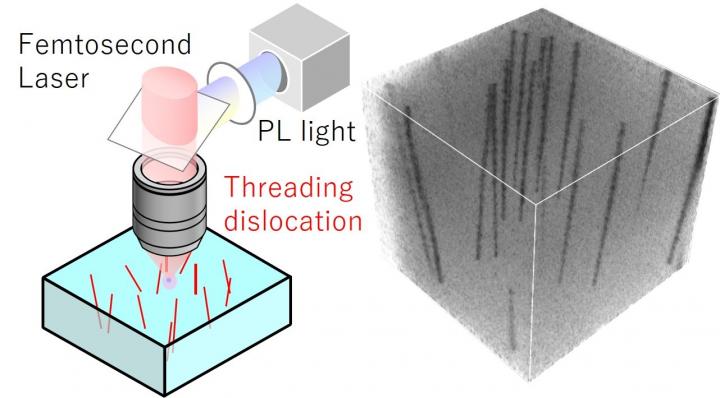Researchers from Osaka University report a nondestructive method for identifying threading dislocations in GaN substrates that could help to improve quality and improve yields

Credit: Osaka University
Osaka – Gallium nitride (GaN) is a semiconductor material whose wide band gap may one day lead to it superseding silicon in electronics applications. It is therefore important to have GaN characterization techniques that are able to support the development of GaN devices. Researchers at Osaka University have reported a nondestructive method for characterizing the crystalline quality of GaN. Their findings were published in Applied Physics Express.
GaN power switching devices offer numerous advantages including high-speed switching, high-power operation, low on-resistance, and high breakdown voltage. To take advantage of these properties, the defect density of GaN crystals must be low.
Threading dislocations (TDs) are a type of crystal defect generated by the imperfection of crystals that propagate from the substrate into an epitaxial layer. These TDs often serve as leakage current paths.
TDs can be classified using their Burgers vectors. A variety of methods can be used to analyze GaN and determine the Burgers vectors of the TDs; however, most have associated limitations, such as involved sample preparation or limited analysis area. The techniques may also require destructive sample preparation, so tested samples cannot be reused.
The researchers therefore used multiphoton excitation photoluminescence (MPPL) to evaluate GaN. MPPL is a nondestructive technique in which the excitation laser light penetrates deep into the samples. It is therefore ideal for the three-dimensional (3D) evaluation of crystal defects in materials.
“We used MPPL to carry out an in-depth study of defects in GaN crystals by analyzing the local photoluminescence properties and the 3D defect structures,” explains study first author Mayuko Tsukakoshi. “Considering our findings along with those of the etch pit method then allowed for statistical classification of the TDs.”
The mixed TDs were found to extend through GaN at large inclination angles. In addition, the contrast of the photoluminescence signals indicated that the screw TDs had stronger nonradiative properties than the others.
“Being able to relate MPPL findings to the quality of GaN crystals provides an excellent tool for nondestructive, high throughput substrate evaluation,” study corresponding author Tomoyuki Tanikawa says. “We believe our findings will help to easily identify defects that affect reliability, as well as improve yields to give more efficient routes to GaN devices.”
###
The article, “Identification of Burgers vectors of threading dislocations in free-standing GaN substrates via multiphoton-excitation photoluminescence mapping,” was published in Applied Physics Express at DOI: https:/
About Osaka University
Osaka University was founded in 1931 as one of the seven imperial universities of Japan and is now one of Japan’s leading comprehensive universities with a broad disciplinary spectrum. This strength is coupled with a singular drive for innovation that extends throughout the scientific process, from fundamental research to the creation of applied technology with positive economic impacts. Its commitment to innovation has been recognized in Japan and around the world, being named Japan’s most innovative university in 2015 (Reuters 2015 Top 100) and one of the most innovative institutions in the world in 2017 (Innovative Universities and the Nature Index Innovation 2017). Now, Osaka University is leveraging its role as a Designated National University Corporation selected by the Ministry of Education, Culture, Sports, Science and Technology to contribute to innovation for human welfare, sustainable development of society, and social transformation.
Website: https:/
Media Contact
Saori Obayashi
[email protected]
Original Source
https:/
Related Journal Article
http://dx.




